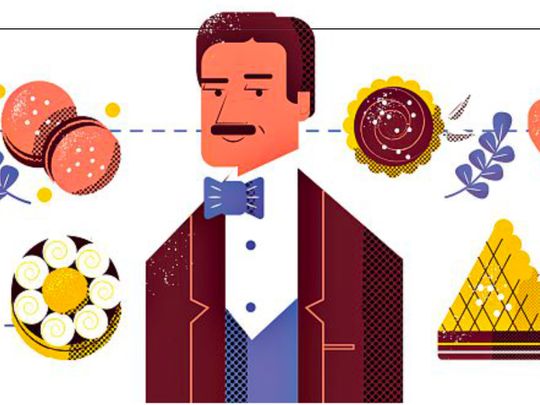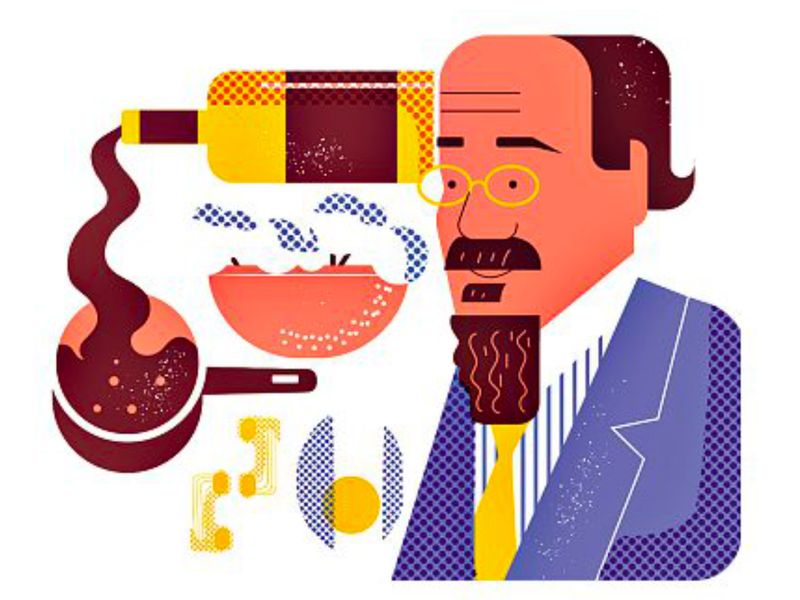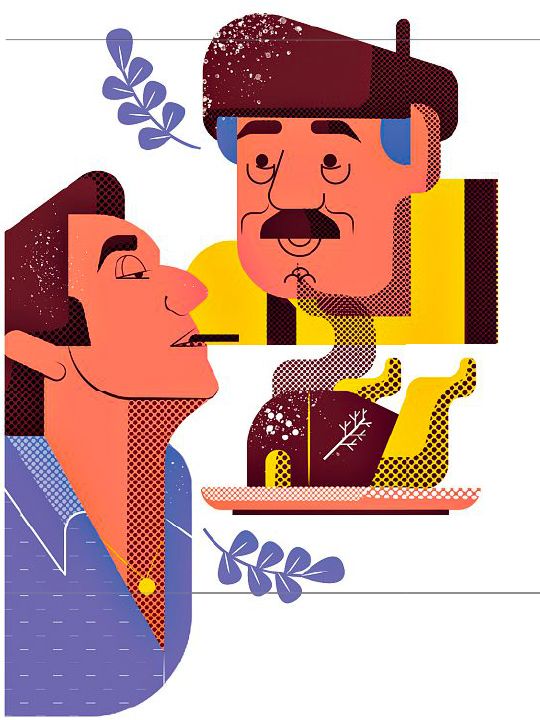
We asked Doctor Michael Chast, author of Je me soigne en mangeant (‘My self-care is eating’) what he thinks, as a nutritionist, about these unusual eating habits.
Interrupted meal
According to Raymond Roussel
Literature lovers regard highly the work of Raymond Roussel, wealthy modern heir of Marcel Proust. The author’s artistic eccentricities in Impressions d’Afrique are only equalled by the eccentricities in his everyday life. As a man who only wore a turtleneck once, the same shirt four times, and the same suit 15 times before giving them to his staff, not being able to tolerate washed clothes because of the risk of bacterial infection, Raymond Roussel could only have extraordinary culinary tastes. These were determined by a farfetched timetable, with Roussel writing through the night, like Balzac. He used to favour grouping the four conventional meals eaten by a middle-class family –breakfast, lunch at midday, a light meal at 5pm and then supper in the evening – into one event from 11am to 5:30pm. The menu started out with fruit sought by a particular driver in the Midi, followed by a tea, coffee or Swiss chocolate soup, accompanied by pastries. This first part of the meal came to its end with a soft Normandy cheese, a Bendon or a Neufchâtel. Without a break, Roussel ate his lunch non-stop: Shellfish or fish starter, followed by pasta or gnocchis, then a meat dish such as stuffed quail or foie gras and a piece of fish interspersed with sorbet, a sort of elegant break during the meal before the main dish (bourguinon or navarin of lamb), roast (leg of lamb or fillet steak), a salad and three desserts, one pastry, the second with cream and the third iced. Roussel took supper in his stride: Two soups, a fish starter, a hot starter such as a truffle omelette, a cold dish, perhaps a foie gras from the Landes, a mixed salad and the inevitable three desserts brought this endless meal to an end, sprinkled with the best champagnes and wines from the owner’s cellar. It seems gargantuan to us, but the remains would pretty much feed the staff. It was 5:30pm and Roussel was ready to start his day…
The nutritionist’s opinion
To facilitate a good digestive system, it is recommended that we eat a number of balanced meals throughout the day. The rich and alcohol-imbued meals of Raymond Roussel don’t help either memory or concentration.

A tinned blow-out
According to Howard P. Lovecraft
If Roussel did not have any obvious digestive problems, his near contemporary, the science-fiction writer Howard P. Lovecraft complained about those he had, to the point where he took only two meals per day. Aware as well of being thrifty, spending less than $3 a week on food (which was not much even at that time), the master of gothic horror stories prioritised dishes based on the famous tins of Bush Brothers white beans which were steeped in meat-flavoured tomato sauce, and to which he sometimes added sausages. Breakfast was invariably porridge and sundaes or ice cream finished off this heavy diet, which was more likely to increase stomach acid than the nightmares which were the source of the majority of his stories. What is most surprising is that, with this diet stripped of all nutrition, Howard P Lovecraft remained very slim all of his life, evidence no doubt that the mind plays a bigger part than we imagine in weight gain.
The nutritionist’s opinion
Dear Howard, in these extremely gloomy meals which lacked any fresh items, where are the five fruit and vegetables recommended today? They provide vital vitamins and minerals for us to function effectively.

Aspirin peas
According to Howard Hughes
Businessman, film producer, plane builder, the American millionaire Howard Hughes sank into dementia, his financial means giving him a free hand to satisfy his obsessive compulsive disorder. As he approached 50 years of age, he began to live in voluntary seclusion, avoiding all personal contact, naked most of the time as he couldn’t bear the feeling of clothes against his skin, and spending entire weeks projecting the same film on a loop. The size of peas, one of his favourite foods, was one of his major obsessions, and he even had a special fork made for sorting them. By whatever means, Howard Hughes sought to protect himself from germs. At the end of his life, his diet consisted of taking 20 or so aspirin tablets.
The nutritionist’s opinion
One opinion is to imagine that we would be in better health if we protect ourselves from germs. It’s frightening to imagine that large quantities of aspirin could replace meals. They only destroy the stomach and the liver.

Chromatic diet
According to Erik Satie
The Gymnopedie musician Erik Satie, in his Mémoires d’un amnésique (‘Memories of an Amnesiac’), described his diet as follows: “I only eat white food: Eggs, sugar, coconut, chicken cooked in either fruit mould, rice or turnips; white sausage in camphor, pasta, (white) cheese, cotton-flower salad and certain fish (without their skins). I have a good appetite; but I never speak when I’m eating, for fear of choking.” Do we have to take him literally? Elsewhere, Erik Satie remembers with pleasure his meals of lamb cutlets with Claude Debussy and talks of his love of lamb. We’ll give him the benefit of the doubt: In his moments of poetic elation (“Inspired from 10:23 to 11:47, I eat lunch at 12:11 and leave the table at 12:14”, he used to say in his Mémoires) he certainly always followed this programme.
The nutritionist’s opinion
It seems impossible to manage a meal well when it takes only three minutes to eat. The colour of the food items matches the trace elements and vitamins we need. White brings instability, colours reinforce our good health.

Coprophagous light meal
According to Michel Simon
In Gainsbourg raconte sa mort (Gainsbourg retells his death) by the journalist Bruno Bayon, the author of 69 Erotic Year mentions the culinary tastes of Michel Simon, the favourite comedian of directors Marcel Carné and Jean Renoir, with his ugly face and his priceless Parisian accent. While tasting woodcock canapés at Lucas Carton’s, one of the best gastronomic restaurants in Paris, Michel Simon revels in the smell of decay that comes from these little birds flambéd. And the singer is reminded of the two women he knew before the war who loved men with particular tastes, “those who are spoon-fed”. From here to thinking that the comedian – owner of a collection of more than 100,000 documents and objects of pleasure – also loved them, and only one step from Serge Gainsbourg crossing the line: “It’s spectacular”, he concludes.
The nutritionist’s opinion
Normal for animals, coprophagy is extremely unusual in humans and is linked to dementia. However, one can use human faeces which have been filtered and transformed in the treatment of chronic digestive illnesses, but never orally.

Precious stones Granola
According to Héliogabale
Emperor for four years, from 218 to 222, Héliogabale had clearly already lost his head when he acceded to the throne of Rome at the age of 14. Caracalla’s illegitimate son did have table manners that were appealing however. Héliogabale started the habit of moving from one palace to another during a feast, eating the first course on the Capitol, then moving from the Palatine to Caelius’s hills with his entire procession of ivory and gold. And for the pleasure of the eyes, the peas were strewn with grains of gold, the lentils with rubies, and the beans with amber. Strange seasoning, but what else would you expect of an emperor who fed his dogs foie gras, his horses grapes, and his lions with pheasants and parrots? Condemned, at his death, to damnatio memoriae, a practice by which all memory of a person was officially obliterated, Héliogabale continued to be remembered by his peers for his madness, as witnessed in Héliogabale or the anarchist crowned by the poet Antonin Artaud.
The nutritionist’s opinion
Alchemists have used stones and metals to help them find the elixir of long life. The madness of Héliogabale most probably caused serious digestive difficulties for his guests.


